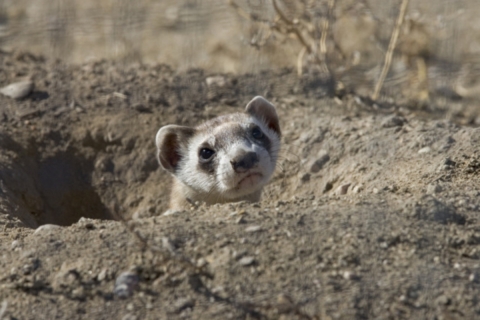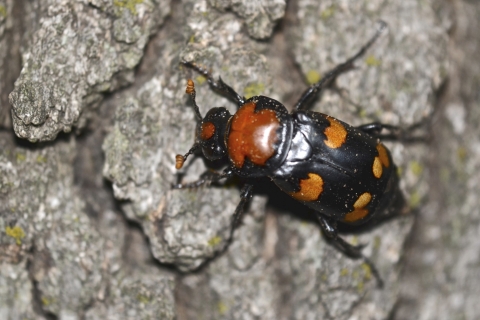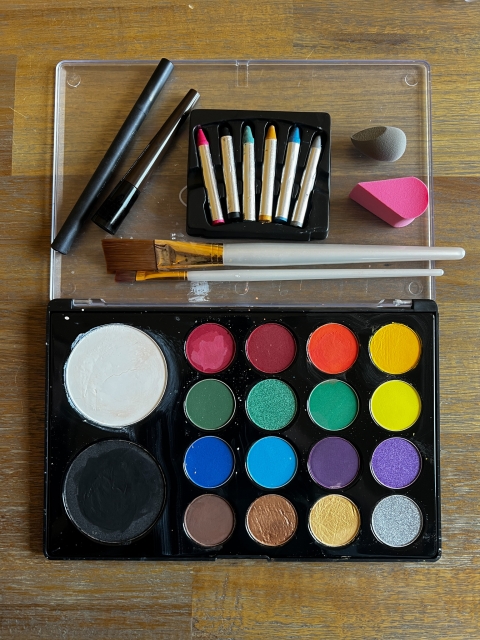Ready to unleash your inner wildlife artist? We're getting ready for Halloween by showing you how to transform into four incredible creatures: the elusive ocelot, the daring black-footed ferret, the armored horned lizard, and nature's undertaker: the American burying beetle. Grab your paintbrushes and some face paint, channel your creativity, and let's start this wild adventure together!
Ocelot
Ocelots (Leopardus pardalis) are a small spotted wild cat native to the Americas. They can be found in the United States in South Texas and sometimes Arizona, as well as nearly every country in Central and South America.
Spot patterns are unique to each ocelot, which means that biologists can use trail cam images to identify each individual ocelot they see.
In the U.S., there are believed to be fewer than 100 resident breeding ocelots, all found in deep South Texas. One population of ocelots is found on private ranches in Willacy, Kenedy, and Kleberg Counties, and a separate population is found in and around the Laguna Atascosa National Wildlife Refuge in Cameron County.
Ocelots populations declined after historical habitat loss and predator control activities like hunting, trapping, and poisoning. The population remaining in Texas is listed as endangered and continues to be threatened by low genetic diversity due to inbreeding, as well as mortalities from vehicle strikes.
We've been working to help the ocelots in Texas recover by restoring the Tamaulipan thornscrub habitat that they need to live and breed, along with private landowners. Our other conservation partners are also working to help ocelots. The Texas Department of Transportation has built 21 animal crossings in South Texas specifically to protect ocelots, with more planned in the next decade.
Step 1: Cover the top half of the face with yellow or yellow orange paint. Add some white around the eyes. We used a makeup sponge for the yellow and paint brush for the white.
Step 2: Add bright pink for the nose, and light pink or tan for the ears. Some white streaks can help give the impression of fur in the ears.
Step 3: Add the black spots using a face paint crayon to maintain the soft edges. Remember, ocelots all have unique spot patterns so this doesn't need to be perfect! Then add the fine black details around the eyes, ears, and nose using a small paintbrush or liquid eyeliner.
Black-footed ferret
Black-footed ferrets (Mustela nigripes) are members of the weasel family, and the only ferret species native to the Americas.
Black-footed ferrets are nocturnal. When a light shines at them in the dark, their eyes reflect green.
Up to 90% of their diets consist of prairie dogs, and the health of the black-footed ferret population is closely tied to that of prairie dogs.
As a result of landscape alterations from agricultural expansion and prairie dog eradication, it was believed that black-footed ferrets were extinct by the 1970s. Then a dog named Shep discovered a wild population in Meeteetse, Wyoming in 1981. This discovery launched the Black-footed Ferret Conservation Recovery Program.
Currently, black-footed ferrets are listed as endangered. Threats such as disease and drought not only affect black-footed ferrets, but also their food source - prairie dog populations. One concern is non-native sylvatic plague, which doesn't infect the ferrets, but can wipe out whole colonies of prairie dogs.
The first cloned U.S. endangered species was a black-footed ferret named Elizabeth Ann. She was born in 2020. It is hoped that cloned animals will help bring some welcome diversity to the population.
Step 1: Cover the top half of the face with white paint. leave space for the dark mask. We used a large brush for this step.
Step 2: Add the darker mask around the eyes. On some ferrets this is lighter in the middle, on some it is dark throughout. Add light pink for the ears, some white streaks again can help give it a furry look.
Step 3: Add the black nose using a paint brush for sharp edges. Add the fine details like the outline of the ears and whiskers with black liquid eyeliner.
American burying beetle
The American burying beetle (Nicrophorus americanus) has Halloween colors with a shiny black body and bright orange markings. It is the largest carrion beetle, or silphid, in North America.
American burying beetles are sometimes called undertaker beetles because they bury carcasses. They use dead animals (carrion) for food and reproduction
A pair of beetles meet at a carcass and bury it together in an underground chamber. They prepare the carcass by stripping off the fur or feathers and covering it with secretions the slow the decomposition. They lay eggs near the carcass and the larvae feed on the carcass as they develop. The adults stay with the young and protect them by killing fly larvae that may compete with the young beetles for food.
Burying beetles are capable of finding a carcass between one and 48 hours following death of prey and at a distance of at least two miles.
American burying beetles are currently listed as threatened. Still working to understand this mysterious creature, biologists hope to answer outstanding questions to improve management practices. For example, what type of carrion is ideal for the beetles now?
Step 1: Paint the reddish orange areas first, to avoid smearing black paint later on. Don't forget the ends of the antennae.
Step 2: Add the black for the rest of the beetle's body, being careful to go around the orange areas. We used a paintbrush for this step.
Step 3: Add the fine black lines of the antennae and legs using black liquid eyeliner.
Horned lizards
There are nine different species of horned lizard that can be found in the U.S. They include the desert horned lizard (Phrynosoma platyrhinos) pictured here, the regal horned lizard (Phrynosoma solare), and the Texas horned lizard (Phrynosoma cornutum).
The generic name Phrynosoma means "toad-bodied". Sometimes called horny toads, they are definitely lizards, just round ones.
Horned lizards have several defensive strategies. First, they rely on camouflage to avoid predators. Their coloration, shape, and spiny scales help break up their outline. Second, they can inflate their bodies to almost twice their normal size, like a spiky little football. And most spectacularly, most species of horned lizards can aim and squirt a stream of blood out of their eyes! That blood contains a compound that makes it smell and taste foul, potentially scaring off a predator like a coyote or bobcat.
Some species of horned lizards are showing marked population declines and are at risk of declining enough to need protections under the Endangered Species Act. The iconic Texas horned lizard, for example, has disappeared from parts of its historical range over the last 30 years. These declines are partly due to habitat loss, and partly due to invasive species invasive species
An invasive species is any plant or animal that has spread or been introduced into a new area where they are, or could, cause harm to the environment, economy, or human, animal, or plant health. Their unwelcome presence can destroy ecosystems and cost millions of dollars.
Learn more about invasive species like fire ants. Fire ants enter an ecosystem and kill or outcompete the native ant species that horned lizards rely on.
Step 1: Using a light tan color, paint the triangle shape of two large horns over the eyes, and additional spines on the side of the face and chin. Remember, the number and arrangement of horns is one of the ways you can tell different species of horned lizards apart.
Step 2: Add dimension and shading by adding some light brown near the ends of the horns/spines.
Step 3: Outline the horns/spines with brown liquid eyeliner, and use hairspray or gel to create additional large horns.
Extra credit: add a little trickle of blood from the inside corner of the eye!
Materials used:
For this project, we had on hand:
- a face paint palette with 18 color choices
- face paint crayons with six color choices
- a large and a small paintbrush
- two makeup sponges
- liquid eyeliner in black and brown
- a cup of water (not pictured).












